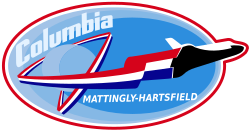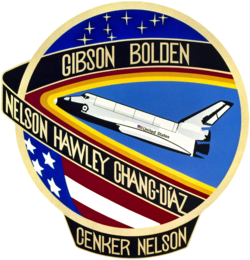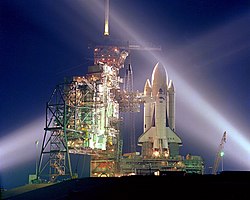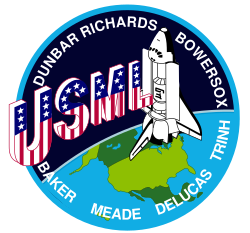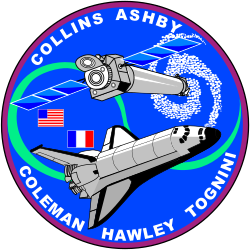Columbia (Raumfähre)

Die Raumfähre Columbia war das erste weltraumtaugliche Space Shuttle der NASA und das erste wiederverwendbare Raumfahrzeug. Im März 1979 fertiggestellt, fand der Jungfernflug am 12. April 1981 statt (STS-1). Die interne Bezeichnung lautet OV-102, wobei OV für Orbiter Vehicle steht. Sie brach am 1. Februar 2003 bei ihrem 28. Weltraumeinsatz (Mission STS-107) beim Wiedereintritt in die Erdatmosphäre auseinander, wobei alle sieben Besatzungsmitglieder ums Leben kamen.
Die Raumfähre wurde – wie das Entdeckerschiff des amerikanischen Seefahrers Robert Gray und die Kommandokapsel von Apollo 11 – nach Columbia benannt, was, vor allem im 18. und 19. Jahrhundert, zunächst die poetische Bezeichnung Nordamerikas und später als weibliche Personifizierung Symbol für die Vereinigten Staaten war.
Geschichte
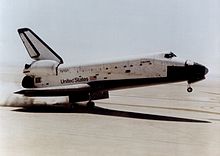
Am 12. April 1981 absolvierte die Columbia mit dem Flug STS-1 den ersten Einsatz eines Space Shuttles im Weltraum unter dem Kommando von John Young. Es war das erste Mal in der Geschichte der NASA, dass ein neues Raumfahrzeug ohne vorherige unbemannte Tests gestartet wurde. Abgesehen von Schäden an den Hitzeschutzkacheln verlief der erste Flug eines Space Shuttles jedoch reibungslos.
Die folgenden vier Space-Shuttle-Flüge wurden ebenfalls mit der Columbia durchgeführt. Zu den späteren Missionen gehörten unter anderem die dritte Hubble-Servicing Mission STS-109 sowie die deutsche D2-Mission mit dem Spacelab. Da sie wegen ihrer schwereren Bauweise etwas weniger Nutzlast tragen konnte und nicht mit einem Docking-Adapter für die Internationale Raumstation ausgestattet war, wurde sie zuletzt vor allem für die wenigen Missionen verwendet, die nicht zur ISS führten.
Absturz

Die Columbia befand sich auf der Rückkehr von ihrer 28. Mission (STS-107) zum Kennedy Space Center, dem US-Weltraumbahnhof, als sie am 1. Februar 2003 gegen 8:59 Uhr Ortszeit (14:59 Uhr MEZ) in 200.800 ft (ca. 61.200 m) Höhe über Texas bei einer Geschwindigkeit von ungefähr 12.385 mph (ca. 19.900 km/h) auseinanderbrach.[1] Ursache war eine Überhitzung des Tragflächeninneren bis zum Erweichen des Materials, hervorgerufen durch ein Loch im Hitzeschild, das durch ein beim Start abgerissenes Schaumstoffteil verursacht worden war. Dabei starben alle sieben Besatzungsmitglieder.
Die Columbia ist nach der Challenger die zweite NASA-Raumfähre, die während einer Mission verunglückte und vollständig zerstört wurde. Auch bei der Challenger-Katastrophe starb die Besatzung.
Missionen
| Nr. | Start | Bezeichnung | Emblem | Besatzung |
|---|---|---|---|---|
| 1 | 12. April 1981 | STS-1 | John Young, Robert Crippen | |
| 2 | 12. November 1981 | STS-2 | Joe Engle, Richard Truly | |
| 3 | 22. März 1982 | STS-3 | Jack Lousma, Gordon Fullerton | |
| 4 | 27. Juni 1982 | STS-4 | Thomas Mattingly, Henry Hartsfield | |
| 5 | 11. November 1982 | STS-5 | Vance Brand, Robert Overmyer, Joseph Allan, William Lenoir | |
| 6 | 28. November 1983 | STS-9 | John Young, Brewster Shaw, Owen Garriott, Robert Parker, Byron Lichtenberg, Ulf Merbold | |
| 7 | 12. Januar 1986 | STS-61-C | Robert Gibson, Charles Bolden, Franklin Chang-Diaz, Steven Hawley, George Nelson, Robert Cenker, William Nelson | |
| 8 | 8. August 1989 | STS-28 | Brewster Shaw, Richard Richards, James Adamson, David Leestma, Mark Brown | |
| 9 | 9. Januar 1990 | STS-32 | Daniel Brandenstein, James Wetherbee, Bonnie Dunbar, David Low, Marsha Ivins | |
| 10 | 2. Dezember 1990 | STS-35 | Vance Brand, Guy Gardner, Jeffrey Hoffman, John Lounge, Robert Parker, Samuel Durrance, Ronald Parise | |
| 11 | 5. Juni 1991 | STS-40 | Bryan O’Connor, Sidney Gutierrez, James Bagian, Tamara Jernigan, Rhea Seddon, Drew Gaffney, Millie Hughes-Fulford | |
| 12 | 25. Juni 1992 | STS-50 | Richard Richards, Kenneth Bowersox, Bonnie Dunbar, Ellen Baker, Carl Meade, Lawrence DeLucas, Eugene Trinh | |
| 13 | 22. Oktober 1992 | STS-52 | James Wetherbee, Michael Baker, Charles Veach, William Shepherd, Tamara Jernigan, Steven MacLean | |
| 14 | 26. April 1993 | STS-55 | Steven Nagel, Terence Henricks, Jerry Ross, Charles Precourt, Bernard Harris, Ulrich Walter, Hans Schlegel | |
| 15 | 18. Oktober 1993 | STS-58 | John Blaha, Richard Searfoss, Rhea Seddon, William S. McArthur, David Wolf, Shannon Lucid, Martin Fettman | |
| 16 | 4. März 1994 | STS-62 | John Casper, Andrew Allen, Pierre Thuot, Charles Gemar, Marsha Ivins | |
| 17 | 8. Juli 1994 | STS-65 | Robert Cabana, James Halsell, Richard Hieb, Carl Walz, Leroy Chiao, Donald Thomas, Chiaki Mukai | |
| 18 | 20. Oktober 1995 | STS-73 | Kenneth Bowersox, Kent Rominger, Kathryn Thornton, Catherine Coleman, Michael López-Alegría, Fred Leslie, Albert Sacco | |
| 19 | 22. Februar 1996 | STS-75 | Andrew Allen, Scott Horowitz, Franklin Chang-Diaz, Maurizio Cheli, Jeffrey Hoffman, Claude Nicollier, Umberto Guidoni | |
| 20 | 20. Juni 1996 | STS-78 | Terence Henricks, Kevin Kregel, Susan Helms, Richard Linnehan, Charles Brady, Jean-Jacques Favier, Robert Thirsk | |
| 21 | 19. November 1996 | STS-80 | Kenneth Cockrell, Kent Rominger, Tamara Jernigan, Thomas Jones, Story Musgrave | |
| 22 | 4. April 1997 | STS-83 | James Halsell, Susan Still-Kilrain, Janice Voss, Donald Thomas, Michael Gernhardt, Roger Crouch, Gregory Linteris | |
| 23 | 1. Juli 1997 | STS-94 | James Halsell, Susan Still-Kilrain, Janice Voss, Donald Thomas, Michael Gernhardt, Roger Crouch, Gregory Linteris | |
| 24 | 19. November 1997 | STS-87 | Kevin Kregel, Steven Lindsey, Winston Scott, Kalpana Chawla, Takao Doi, Leonid Kadenjuk | |
| 25 | 13. April 1998 | STS-90 | Richard Searfoss, Scott Altman, Richard Linnehan, Dafydd Williams, Kathryn Hire, Jay Buckey, James Pawelczyk | |
| 26 | 23. Juli 1999 | STS-93 | Eileen Collins, Jeffrey Ashby, Steven Hawley, Catherine Coleman, Michel Tognini | |
| 27 | 1. März 2002 | STS-109 | Scott Altman, Duane Carey, John Grunsfeld, Nancy Currie, James Newman, Richard Linnehan, Michael Massimino | |
| 28 | 16. Januar 2003 | STS-107 | Rick Husband, William McCool, Michael Anderson, Kalpana Chawla, David Brown, Laurel Clark, Ilan Ramon |
Siehe auch
- Liste von Katastrophen der Raumfahrt
- Geschichte der Raumfahrt
Weblinks
- NASA: Columbia (OV-102) (englisch)
- Columbia in der Encyclopedia Astronautica (englisch)
- NASASpaceflight.com: Chronik der Raumfähre Columbia, Teil 1 und Teil 2 (englisch)
- Sven Preger: 16.01.2003 - Letzter Start der Raumfähre Columbia WDR ZeitZeichen vom 16. Januar 2013. (Podcast)
Einzelnachweise
- ↑ Columbia Accident Investigation Board: STS-107 Re-entry Trajectory and Timeline. (PDF) In: Report of Columbia Accident Investigation Board, Volume I. 26. August 2003, S. 41, abgerufen am 15. Juli 2017 (englisch).
Auf dieser Seite verwendete Medien
STS-28 mission patch
- The STS-28 insignia was designed by the astronaut crew, who said it portrays the pride the American people have in their manned spaceflight program. It depicts America (the eagle) guiding the space program (the Space Shuttle) safely home from an orbital mission. The view looks south on Baja California and the west coast of the United States as the space travelers re-enter the atmosphere. The hypersonic contrails created by the eagle and Shuttle represent the American flag. The crew called the simple boldness of the design symbolic of America's unfaltering commitment to leadership in the exploration and development of space.
STS-5 mission insignia
This mission patch for mission STS-80 depicts the Space Shuttle Columbia and the two research satellites its crew deployed into the blue field of space. The uppermost satellite is the Orbiting Retrievable Far and Extreme Ultraviolet Spectrograph-Shuttle Pallet Satellite (ORFEUS-SPAS), a telescope aimed at unraveling the life cycles of stars and understanding the gases that drift between them. The lower satellite is the Wake Shield Facility (WSF), flying for the third time. It will use the vacuum of space to create advanced semiconductors for the nation's electronics industry. ORFEUS and WSF are joined by the symbol of the Astronaut Corps, representing the human contribution to scientific progress in space. The two bright blue stars represent the mission's Extravehicular Activities (EVA), final rehearsals for techniques and tools to be used in assembly of the International Space Station (ISS). Surrounding Columbia is a constellation of 16 stars, one for each day of the mission, representing the stellar talents of the ground and flight teams that share the goal of expanding knowledge through a permanent human presence in space.
This is the official insignia for STS-9, the major payload of which is Spacelab 1, depicted in the cargo bay of the Columbia. The nine stars and the path of the orbiter tell the flight's numerical designation in the Space Transportation System's mission sequence. Astronaut John N. Young is crew commander, Brewster N. Shaw, Jr., pilot. NASA Astronauts Owen K. Garriott and Robert A. Parker are mission specialists. Byron K. Lichtenberg of the Massachusetts Institute of Technology and Ulf Merbold of the Republic of West Germany are the Spacelab 1 payload specialists. Launch has been set for late 1983. Merbold is a physicist representing the European Space Agency (ESA).
The STS-87 patch is shaped like a space helmet symbolizing the Extravehicular Activity (EVA) on the mission in support of testing of tools for the assembly of the International Space Station (ISS). Earth is shown reflected on the backside of the helmet. The Space Shuttle Columbia forms the interface between the Earth and the heavens, the back and front sides of the helmet in profile. The three red lines emerging from Columbia represent the astronaut symbol as well as the robot arm, which was used to deploy and retrieve the Spartan satellite.
The text 'µg' represents the payloads studying microgravity science in space on this United States Microgravity Payload (USMP-4) mission. Gold flames outlining the helmet visor represent the corona of the Sun, which will be studied by Spartan. The flag of Ukraine is next to the name of the payload specialist who is the first person from that nation to fly on the Space Shuttle.
The STS-78 patch links past with present to tell the story of its mission and science through a design imbued with the strength and vitality of the 2-dimensional art of North America's northwest coast Indians. Central to the design is the space Shuttle whose bold lines and curves evoke the Indian image for the eagle, a native American symbol of power and prestige as well as the national symbol of the United States. The wings of the Shuttle suggest the wings of the eagle whose feathers, indicative of peace and friendship in Indian tradition, are captured by the U forms, a characteristic feature of Northwest coast Indian art. The nose of the Shuttle is the strong downward curve of the eagle's beak, and the Shuttle's forward windows, the eagle's eyes, represented through the tapered S forms again typical of this Indian art form.
The basic black and red atoms orbiting the mission number recall the original NASA emblem while beneath, utilizing Indian ovoid forms, the major mission scientific experiment package LMS (Life and Materials Sciences) housed in the Shuttle's cargo bay is depicted in a manner reminiscent of totem-pole art. This image of a bird poised for flight, so common to Indian art, is counterpointed by an equally familiar Tsimshian Indian symbol, a pulsating sun with long hyperbolic rays, the symbol of life. Within each of these rays are now encased crystals, the products of this mission's 3 major, high-temperature materials processing furnaces. And as the sky in Indian lore is a lovely open country, home of the Sun Chief and accessible to travelers through a hole in the western horizon, so too, space is a vast and beckoning landscape for explorers launched beyond the horizon.
Beneath the Tsimshian sun, the colors of the earth limb are appropriately enclosed by a red border representing life to the Northwest coast Indians. The Indian colors of red, navy blue, white, and black pervade the STS-78 path. To the right of the Shuttle-eagle, the constellation Delphinus recalls the dolphin, friend of ancient sailors and, now perhaps too, of the 9 space voyagers suggested by this constellation's blaze of 9 stars. The patch simultaneously celebrates international unity fostered by the Olympic spirit of sports competition at the 1996 Olympic Games in Atlanta, Georgia, U.S.A. Deliberately poised over the city of Atlanta, the Space Shuttle glows at its base with the 5 official Olympic rings in the 5 Olympic colors which can also be found throughout the patch, rings and colors which signify the 5 continents of the earth. This is an international mission and for the first time in NASA patch history, astronauts have dispensed with identifying country flags beneath their names to celebrate the spirit of international unity so characteristic of this flight.The crew patch of STS-73, the second flight of the United States Microgravity Laboratory (USML-2), depicts the Space Shuttle Columbia in the vastness of space. In the foreground are the classic regular polyhedrons that were investigated by Plato and later Euclid. The Pythagoreans were also fascinated by the symmetrical three-dimensional objects whose sides are the same regular polygon. The tetrahedron, the cube, the octahedron, and the icosahedron were each associated with the Natural Elements of that time: fire (on this mission represented as combustion science); Earth (crystallography), air and water (fluid physics). An additional icon shown as the infinity symbol was added to further convey the discipline of fluid mechanics. The shape of the emblem represents a fifth polyhedron, a dodecahedron, which the Pythagoreans thought corresponded to a fifth element that represented the cosmos.
STS-62 Mission Insignia
STS-32 Mission Insignia
- The STS-32 patch, designed by the five crewmembers for the January, 1990 space mission, depicts the Space Shuttle orbiter rendezvousing with the Long Duration Exposure Facility (LDEF) satellite from above and the Syncom satellite successfully deployed and on its way to geosynchronous orbit. Five stars represent the mission number with three on one side of the orbiter and two on the other. The seven major rays of the sun are in remembrance of the crewmembers for STS 51-L. In preparation for the first Extended Duration Orbiter (EDO) missions, STS-32 conducted a number of medical and middeck scientific experiments. The caduceus on the left represents the medical experiments, and the crystalline structure on the right represents the materials science. The crew is comprised of Astronauts Daniel C. Brandenstein, James D. Wetherbee, Bonnie Dunbar, Marsha S. Ivins, and G. David Low.
STS-52 Columbia, Orbiter Vehicle (OV) 102, crew insignia (logo), the Official insignia of the NASA STS-52 mission, features a large gold star to symbolize the crew's mission on the frontiers of space. A gold star is often used to symbolize the frontier period of the American West. The red star in the shape of the Greek letter lambda represents both the laser measurements to be taken from the Laser Geodynamic Satellite (LAGEOS II) and the Lambda Point Experiment, which is part of the United States Microgravity Payload (USMP-1). The LAGEOS II is a joint Italian \ United States (U.S.) satellite project intended to further our understanding of global plate tectonics. The USMP-1 is a microgravity facility which has French and U.S. experiments designed to test the theory of cooperative phase transitions and to study the solid\liquid interface of a metallic alloy in the low gravity environment. The remote manipulator system (RMS) arm and maple leaf are emblematic of the Canadian payload specialist Steven MacLean.
The Space Shuttle Columbia continues its morning rollout from the Vehicle Assembly Building to Launch Pad 39B in preparation for the STS-90 mission. The Neurolab experiments are the primary payload on this nearly 17-day space flight. Investigations during the Neurolab mission will focus on the effects of microgravity on the nervous system. Specifically, experiments will study the adaptation of the vestibular system, the central nervous system, and the pathways that control the ability to sense location in the absence of gravity, as well as the effect of microgravity on a developing nervous system. The crew of STS-90, slated for launch April 16 at 2:19 p.m. EDT, includes Commander Richard Searfoss, Pilot Scott Altman, Mission Specialists Richard Linnehan, Dafydd (Dave) Williams, M.D., and Kathryn (Kay) Hire, and Payload Specialists Jay Buckey, M.D., and James Pawelczyk, Ph.D.
Emblem of Nasa's STS-109 mission.
STS-55 Mission Insignia
Logo of Sts-3 mission
STS-65 Mission Insignia
Aufstieg der Raumfähre Atlantis am 2. Dezember 1988 mit der Mission STS-27.
STS-40 Mission Insignia
STS-35 Mission Insignia
Emblem of Nasa's STS-4 mission.
STS-61-c mission patch
- Columbia, which opened the era of the Space Transportation System with four orbital flight tests, is featured in re-entry in the emblem designed by the STS-61C crew representing the seven team members who manned the vehicle for its seventh STS mission. Gold lettering against black background honors the astronaut crewmembers on the delta pattern surrounding colorful re-entry shock waves, and the payload specialists are honored similarly below the sphere.
The crew patch for NASA's STS-83 mission depicts the Space Shuttle Columbia launching into space for the first Microgravity Sciences Laboratory 1 (MSL-1) mission. MSL-1 investigated materials science, fluid dynamics, biotechnology, and combustion science in the microgravity environment of space, experiments that were conducted in the Spacelab Module in the Space Shuttle Columbia's cargo bay. The center circle symbolizes a free liquid under microgravity conditions representing various fluid and materials science experiments. Symbolic of the combustion experiments is the surrounding starburst of a blue flame burning in space. The 3-lobed shape of the outermost starburst ring traces the dot pattern of a transmission Laue photograph typical of biotechnology experiments. The numerical designation for the mission is shown at bottom center. As a forerunner to missions involving International Space Station (ISS), STS-83 represented the hope that scientific results and knowledge gained during the flight will be applied to solving problems on Earth for the benefit and advancement of humankind.
STS-58 Crew Insignia
Eine Langzeitbeleuchtung der ersten Space Shuttle Mission, STS-1 vor dem Start. Shuttle Columbia steht auf dem Launch Pad A des Complex 39 im KSC .
STS-90 insignia
- The STS-90 crew patch reflects the dedication of the mission to neuroscience in celebration of the decade of the brain. Earth is revealed through a neuron-shaped window, which symbolizes new perspectives in the understanding of nervous system development, structure and function, both here on Earth and in the microgravity environment of space.
- The Space Shuttle Columbia is depicted with its open payload bay doors revealing the Spacelab within. An integral component of the mission, the laboratory/science module provided by the European Space Agency (ESA), signifies the strong international involvement in the mission. The seven crew members and two alternate payload specialists, Chiaki Naito-Mukai and Alexander W. Dunlap, are represented by the nine major stars of the constellation Cetus (the whale) in recognition of the International Year of the Ocean.
- The distant stars illustrate the far reaching implications of the mission science to the many sponsoring agencies, helping prepare for long-duration space flight aboard the International Space Station (ISS).
- The moon and Mars are depicted to reflect the crew's recognition that those two celestial bodies will be the next great challenges in human exploration of space and represent the key role that life science research will play in supporting such missions.
STS-94 insignia
Mission patch for STS-2 Space Shuttle mission
Emblem of Nasa's STS-50 mission.
STS-75 Mission Insignia
STS-1 CREW PATCH
This is the official insignia for the first Space Shuttle orbital flight test (STS-1). Crew of the 102 Columbia on STS-1 was Astronauts John W. Young, commander, and Robert Crippen, pilot. The art work was done by artist Robert McCall.
Emblem of Nasa's STS-93 mission.
- The STS-93 mission patch, as designed by the five crew members. The STS-93 mission carried the Chandra X-Ray Observatory into low Earth orbit initiating its planned five-year astronomy mission. Chandra is the third of NASA’s great observatories, following the Hubble Space Telescope and the Compton Gamma Ray Observatory. Chandra provides scientists an order-of-magnitude improvement over current capabilities at X-Ray wavelengths. Observations of X-Ray emissions from energetic galaxies and clusters, as well as black holes, promise to greatly expand current understanding of the origin and evolution of our universe. The STS-93 patch depicts Chandra separating from the Space Shuttle Columbia after a successful deployment. A spiral galaxy is shown in the background as a possible target for Chandra observations. The two flags represent the international crew, consisting of astronauts from both the United States and France.
STS107-S-001 (May 2001) This is the insignia for w:STS-107, which is a multi-discipline microgravity and Earth science research mission with a multitude of international scientific investigations conducted continuously during the planned 16 days on orbit. The central element of the patch is the microgravity symbol, µg, flowing into the rays of the astronaut symbol. The mission inclination is portrayed by the 39 degree angle of the astronaut symbol to the Earth's horizon. The sunrise is representative of the numerous experiments that are the dawn of a new era for continued microgravity research on the International Space Station and beyond. The breadth of science conducted on this mission will have widespread benefits to life on Earth and our continued exploration of space illustrated by the Earth and stars. The constellation Columba (the dove) was chosen to symbolize peace on Earth and the Space Shuttle Columbia. The seven stars also represent the mission crew members and honor the original astronauts who paved the way to make research in space possible. The Israeli flag is adjacent to the name of the payload specialist who is the first person from that country to fly on the Space Shuttle.
Space Shuttle Columbia landing on Rogers dry lake bed at Edwards Air Force Base, California after the completion of STS-1, the first shuttle mission. Reentry of the shuttle occurs above the speed of sound and causes a sonic boom which can be heard over the entire Antelope Valley.



















